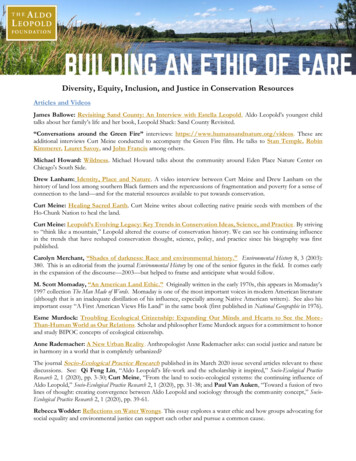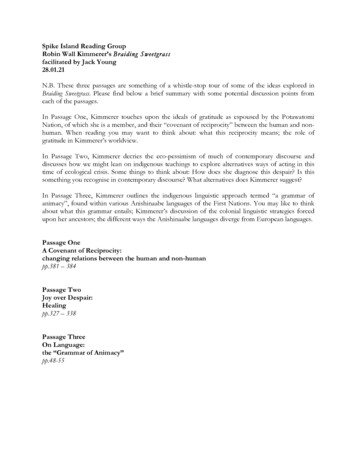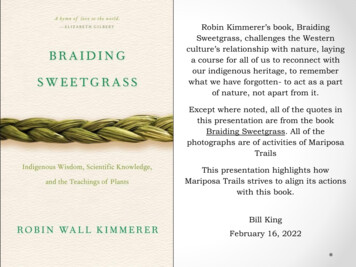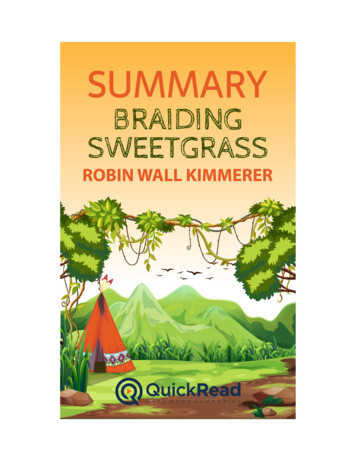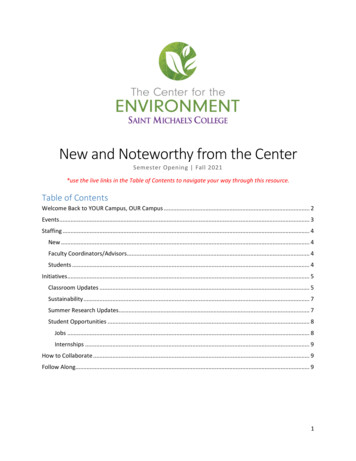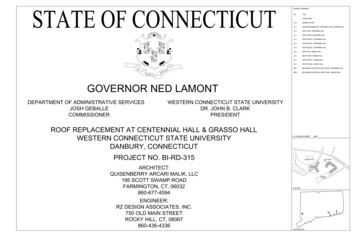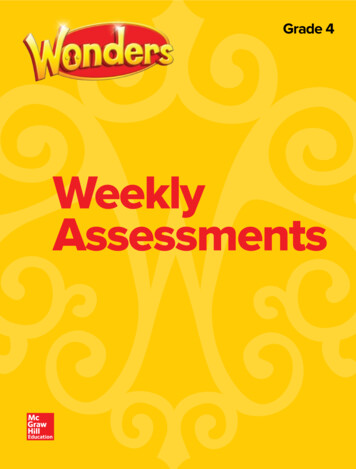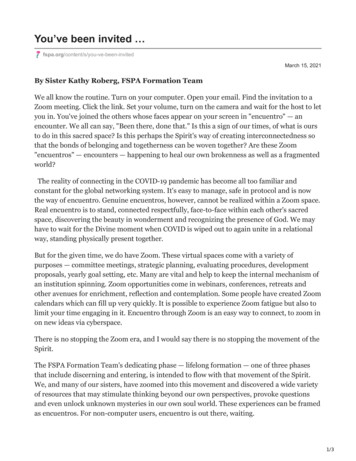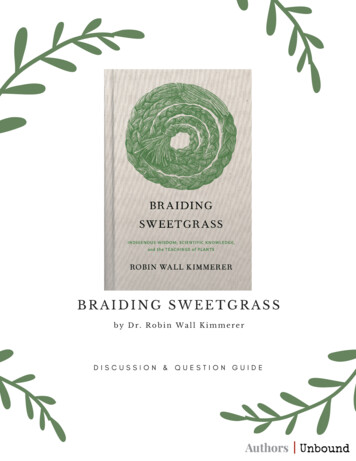
Transcription
BRAIDING SWEETGRASSby Dr. Robin Wall KimmererD I S C U S S I O N&Q U E S T I O NG U I D E
AN OVERVIEWWhat is sweetgrass – Hierochloe odorata – wiingaashk? Robin Wall Kimmerer, “a mother,scientist, decorated professor, and enrolled member of the Citizen Potawatomi Nation,”eloquently and beautifully uses the indigenous cultures’ sacred plant, sweetgrass, as a poeticmetaphor to explain the origins of plant, animal, and human life on Mother Earth, theirintertwined respectful and reciprocal relationships with each other, the loss of this reciprocity,and the hope of ecological restoration to return the gifts of Mother Earth and the balance thatonce was.Robin Wall Kimmerer provides the reader with the definition and explanation of thesignificance of sweetgrass’s scientific name, Hierochloe odorata -- “the fragrant, holy grass.” Inher language, “it is called wiingaashk – the sweet-smelling hair of Mother Earth. Breathe it inand you start to remember things you didn’t know you’d forgotten.” (Preface)Dr. Kimmerer presents this book as a gift of braided stories “meant to heal our relationshipwith the world” by weaving together the three strands of “indigenous ways of knowing,scientific knowledge, and the story of an Anishinabekwe scientist trying to bring them togetherin service to what matters most.” That is, the necessity for humankind to be rejoined with itsrelationships to nature, and to understand the implications of the Earth’s gifts and ourresponsibility to return these gifts. Although Dr. Kimmerer recounts specific examples of ourloss of respectful relationships with nature and the resultant destruction and devastation, shedoes provide a hopeful challenge to humankind to “ honor our responsibilities for all we havebeen given, for all that we have taken. Whatever our gift, we are called to give it and to dancefor the renewal of the world.” (p. 384)
SECTION 1: PLANTING SWEETGRASS(PP. 3-59*)Throughout the six chapters in this section, the reader is presented with many indigenous teachings,scientific knowledge, the philosophical dilemmas Dr. Kimmerer faced upon entering her scientificstudies, personal experiences with nature and her indigenous teachings during her formative years,and the reawakening of her original questions as a result of reconnecting with the last nine fluentPotowatomi speakers. The themes of reciprocity, the spirit of community, a gift economy versus aproperty (market) economy, gratitude, the four aspects of being—mind, body, emotion, and spirit—and the learning of the language of animacy are brought to the forefront quite fervently.DISCUSSION QUESTIONS1. In the story, ‘Skywoman Falling’, the indigenous Creation story (pp. 3-10), you learnthat Skywoman lived as if her children’s future mattered. If you truly focus on the Earththat will be left for your grandchildren, how would you live differently?2. Kimmerer states, in Native ways of knowing, human people are often referred to as“the younger brothers of Creation.” (p. 9) Do you agree that humans can learn fromplants and animals? If so, how can we humble ourselves to “listen” to the wisdom of theplants?3. In the ‘Council of Pecans’ (pp. 11-21), we learn that trees teach the “Spirit ofCommunity” in which what is good for one is good for all. If you believed that the earthbelongs to everybody as a community, would you be more invested in its health? Why?4. Does the concept of trees having a community relationship, and the scientificexplanations of their possible means of communications change how you view ourrelationship with forests? If so, how?5. The ‘Gift of Strawberries’ (pp. 22-32) introduces the reader to the concept of “theessence of a gift economy is, at its root, reciprocity.” (p. 28) How can “the relationship ofgratitude and reciprocity that has been developed increase the evolutionary fitness ofboth plant and animal”? (p. 30).6. Do you see the earth as property or as a gift? How does this perspective change theway in which you view the value of what you take from the earth?*Page numbers refer to Braiding Sweetgrass by Robin Wall Kimmerer as published by MilkweedEditions (First Paperback Edition) 2013
7. ‘An Offering’ (pp. 33-38) provides insight into Kimmerer’s understanding of themeaning of ceremony that is “fed from the same bond with the land, founded onrespect and gratitude.” (p. 36) How can we express our gratitude and responsibility forthe gifts of the land? What can we offer earth in return?8. ‘Asters and Goldenrod’ (pp. 39-47) delves into Kimmerer’s need to question and toknow about the relationship between these flowers. “It was an architecture ofrelationships, of connections that I yearned to understand.” (p. 46) She discovered a“lived reciprocity” between asters and goldenrod—“the pairing of purple and gold.”What is the interdependency between humans and plants? And, what happens if wedon’t live up to our end of the relationship?9. ‘Learning the Grammar of Animacy’ (pp. 48-59) introduces the concept ofcommuning with nature by getting to know more about plants and recognizing thatthey are not inanimate objects. What can you do to start learning about the plants inyour immediate environment? If you addressed the plants as something other than “it,”would that change your attitude? How?SECTION 2: TENDING SWEETGRASS(PP. 64-117*)Through illustrative, indigenous stories and personal memoirs, Kimmerer expands on the need tonurture reciprocal relationships between humans and plants. She asserts that these relationships arerequired if we are to assure the habitats’ survival, e.g., “weeding and care for the habitat andneighboring plants strengthens its growth.”(p. 60) The themes of reciprocity and gratitude arecontinued in stories about the gifts we receive from nature and, in turn, our responsibility to returnthose gifts by, at a minimum, recognition of the gifts and expressions of thanksgiving.DISCUSSION QUESTIONS1. In the story ‘Maple Sugar Moon’ (pp. 63-71), Nanabozho finds that people have grownlazy due to the bounty of the first Maple trees. Nanabozho removes this culture ofplenty by diluting the sap and teaching the people to honor and respect the gift of theMaple tree. Can you draw any parallels from this story and our consumer-driveneconomy? In what ways are we wasting earth’s gifts – its non-renewable, naturalresources?2. In ‘Allegiance to Gratitude’ (pp. 103-117), Kimmerer introduces the ThanksgivingAddress used by the indigenous people to give thanks to the land. She states, “.it is thecredo for a culture of gratitude.” (p. 115) How does the Thanksgiving Address supportthe concept of “our mutual allegiance as human delegates to the democracy of thespecies”? (p. 116) What does that mean to you?*Page numbers refer to Braiding Sweetgrass by Robin Wall Kimmerer as published by MilkweedEditions (First Paperback Edition) 2013
SECTION 3: PICKING SWEETGRASS(PP. 121-204*)The reciprocity theme continues in this section with an emphasis upon the gifts the land provides,finding our unique gifts to give in return, how our gifts can be used to foster the sense of community,and how “plants teach in a universal language: food.” (p. 129) ‘The Three Sisters’ (pp. 128 - 140) story isespecially poignant and informative. The reader learns that “ the lessons of reciprocity are writtenclearly in a Three Sisters garden. Together their stems inscribe what looks to me like a blueprint forthe world, a map of balance and harmony.” When corn, beans, and squash are planted together, their“organic symmetry of forms belongs together Respect one another, support one another, bring yourgift to the world and receive the gifts of others, and there will be enough for all.” (p. 132)‘The Honorable Harvest’ (pp. 175 – 201) “ asks us to give back, in reciprocity, for what we have beengiven.” (p. 190) The Guidelines of the Honorable Harvest are presented as rules that “ are based onaccountability to both the physical and the metaphysical worlds.” (p. 183) Kimmerer discusses theculture of gratitude as a springboard for a culture of reciprocity, and the differences betweenreciprocity and the modern ecological movement towards sustainability.DISCUSSION QUESTIONS1. What do each of The Three Sisters – corn, beans, and squash - bring to theirreciprocal relationship? How can this partnership create a stronger community? Canyou think of other examples of such win-win situations?2. In our consumer-driven society, how can we put into realistic practice the covenantsof The Honorable Harvest? How can we teach people to “remember that what’s goodfor the land is also good for the people”? (p. 195)SECTION 4: BRAIDING SWEETGRASS(PP. 205-302*)The significance of braiding plaits of sweetgrass into three strands is symbolic of the philosophy andspirituality of the indigenous people. Sweetgrass is a sacred, healing plant to the Potawatomi peopleand is braided “ as if it were our mother’s hair, to show our loving care for her.” (p. 263) Kimmerershares the meaning of becoming indigenous to a place, of how the land is the “real teacher” (p. 222),and the methodology she used with her ethnobotany students to enlighten them to the fact that “Theplants adapt, the people adopt.” (p. 229) In addition, she elaborates on the purpose of ceremony andhow “ the community creates ceremony and the ceremony creates communities.” (p. 250)Preserving the relationship between plants and people through ecological restoration is anotherexample of the need for listening to the plants. Kimmerer states in the ‘Umbilicaria: The Belly Buttonof the World’ chapter, “ lichens are born from reciprocity. They remind us of the enduring powerthat rises from mutualism, from the sharing of the gifts carried by each species.” (p. 275)*Page numbers refer to Braiding Sweetgrass by Robin Wall Kimmerer as published by MilkweedEditions (First Paperback Edition) 2013
DISCUSSION QUESTIONS1. In ‘Putting Down Roots’ (pp. 254 – 267), Kimmerer states, “Losing a plant can threatena culture in much the same way as losing a language.” (p. 261) On the basis ofKimmerer’s discussion in this chapter regarding sweetgrass’s decline, how can plantsrepeat the history of their people? (p. 262) What are some examples presented byKimmerer that would support her statement, “Reciprocity is a key to success.”? (p. 262)2. The chapter, ‘Old-Growth Children’ (pp. 277 – 292), captures the essence ofsustainability and how we can learn from an old-growth forest. What tools do forestecosystems have for “dealing with massive disturbance ”? (p 283) What is thedifference between industrial forestry and sustainable forestry? (p. 285) What can welearn from the extermination of old-growth ecosystems in the past and present? Whatcan our role be in the regeneration of these ecosystems? (p. 284)SECTION 5: BURNING SWEETGRASS(PP. 303-379*)“A Sweetgrass braid is burned to create a ceremonial smudge that washes the recipient in kindnessand compassion to heal the body and the spirit.” (p. 301) Conversely, in ‘Windigo Footprints’ (pp. 303– 309), Kimmerer draws parallels between the indigenous people’s stories of the Windigo monsterand the greedy nature of mankind today that allows for the destruction of nature’s structures, habitats,and balance in the name of progress and profit. This selfish behavior is our Windigo.The need for the healing of the land and the ecological restoration of the gifts that Mother Earth hasgiven us is passionately presented in the ‘The Sacred and the Superfund’ (pp. 310 – 340) chapter.Onondaga Lake, located outside of Syracuse, New York, was turned into a Superfund site followingyears of destructive industrial misuse that began prior to 1940 and continued into the 1970’s.Kimmerer states that “scarcely thirty years ago, covering up your mess passed for responsibility—akind of land-as-litter-box approach.” (p. 329) She points out the difference in the approach toecological restoration when land is “just real estate, then restoration looks very different than if land isthe source of a subsistence economy and a spiritual home. Restoring land for production of naturalresources is not the same as renewal of land as cultural identity.” (p. 328)DISCUSSION QUESTIONS1. Kimmerer states that “we seem to be living in an era of Windigo economics offabricated demand and compulsive overconsumption” (p. 308) In addition, “Ourleaders willfully ignore the wisdom and the models of every other species on the planet—except of course those that have gone extinct. Windigo thinking.” (p. 309) Can youprovide examples of unnecessary overconsumption? What would we need to change inour society to stop these practices?*Page numbers refer to Braiding Sweetgrass by Robin Wall Kimmerer as published by MilkweedEditions (First Paperback Edition) 2013
2. “The Onondaga people still live by the precepts of the Great Law and still believethat, in return for the gifts of Mother Earth, human people have responsibility forcaring for the nonhuman people, for stewardship of the land.” (p. 319) What do youbelieve are the responsibilities of our government and our society in aiding theOnondaga Nation in its efforts to restore Onondaga Lake to a healthy state?3. Reflect upon Kimmerer’s statement “environmentalism becomes synonymous withdire predictions and powerless feelings.” (p. 327) What action can you take within yourcommunity to bring about positive environmentalism and ecologicalrestoration/preservation?4. Based upon the central themes as presented by Dr. Kimmerer in Braiding Sweetgrass,explain the differences between reciprocity and the current ecological movementknown as sustainability.Prepared by The Longwood Gardens Library and Archives*Page numbers refer to Braiding Sweetgrass by Robin Wall Kimmerer as published by MilkweedEditions (First Paperback Edition) 2013
The significance of braiding plaits of sweetgrass into three strands is symbolic of the philosophy and. spirituality of the indigenous people. Sweetgrass is a sacred, healing plant to the Potawatomi people. and is braided " as if it were our mother's hair, to show our loving care for her." (p. 263) Kimmerer
